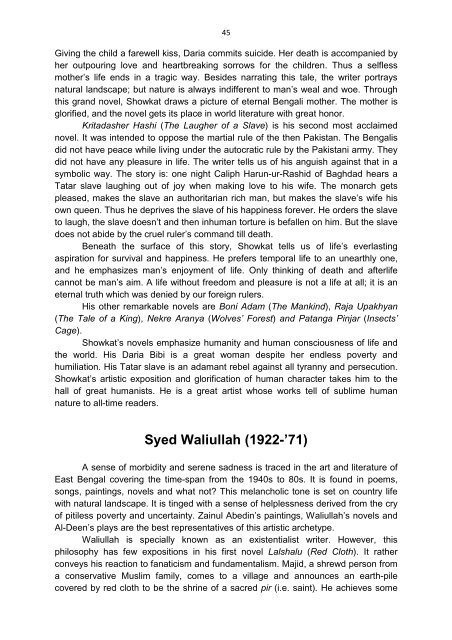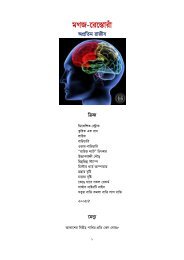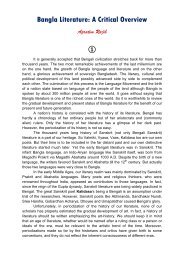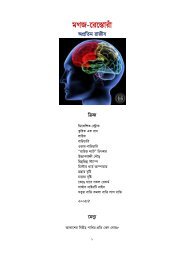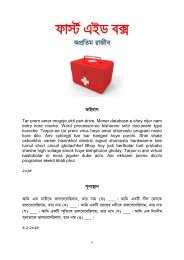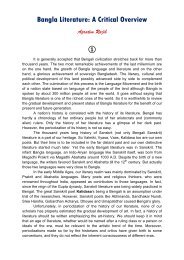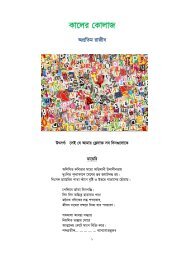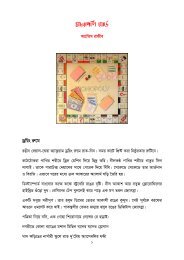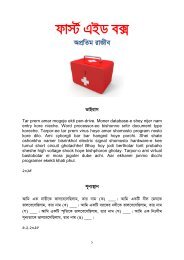BLiterature-Apratim
You also want an ePaper? Increase the reach of your titles
YUMPU automatically turns print PDFs into web optimized ePapers that Google loves.
45<br />
Giving the child a farewell kiss, Daria commits suicide. Her death is accompanied by<br />
her outpouring love and heartbreaking sorrows for the children. Thus a selfless<br />
mother’s life ends in a tragic way. Besides narrating this tale, the writer portrays<br />
natural landscape; but nature is always indifferent to man’s weal and woe. Through<br />
this grand novel, Showkat draws a picture of eternal Bengali mother. The mother is<br />
glorified, and the novel gets its place in world literature with great honor.<br />
Kritadasher Hashi (The Laugher of a Slave) is his second most acclaimed<br />
novel. It was intended to oppose the martial rule of the then Pakistan. The Bengalis<br />
did not have peace while living under the autocratic rule by the Pakistani army. They<br />
did not have any pleasure in life. The writer tells us of his anguish against that in a<br />
symbolic way. The story is: one night Caliph Harun-ur-Rashid of Baghdad hears a<br />
Tatar slave laughing out of joy when making love to his wife. The monarch gets<br />
pleased, makes the slave an authoritarian rich man, but makes the slave’s wife his<br />
own queen. Thus he deprives the slave of his happiness forever. He orders the slave<br />
to laugh, the slave doesn’t and then inhuman torture is befallen on him. But the slave<br />
does not abide by the cruel ruler’s command till death.<br />
Beneath the surface of this story, Showkat tells us of life’s everlasting<br />
aspiration for survival and happiness. He prefers temporal life to an unearthly one,<br />
and he emphasizes man’s enjoyment of life. Only thinking of death and afterlife<br />
cannot be man’s aim. A life without freedom and pleasure is not a life at all; it is an<br />
eternal truth which was denied by our foreign rulers.<br />
His other remarkable novels are Boni Adam (The Mankind), Raja Upakhyan<br />
(The Tale of a King), Nekre Aranya (Wolves’ Forest) and Patanga Pinjar (Insects’<br />
Cage).<br />
Showkat’s novels emphasize humanity and human consciousness of life and<br />
the world. His Daria Bibi is a great woman despite her endless poverty and<br />
humiliation. His Tatar slave is an adamant rebel against all tyranny and persecution.<br />
Showkat’s artistic exposition and glorification of human character takes him to the<br />
hall of great humanists. He is a great artist whose works tell of sublime human<br />
nature to all-time readers.<br />
Syed Waliullah (1922-’71)<br />
A sense of morbidity and serene sadness is traced in the art and literature of<br />
East Bengal covering the time-span from the 1940s to 80s. It is found in poems,<br />
songs, paintings, novels and what not? This melancholic tone is set on country life<br />
with natural landscape. It is tinged with a sense of helplessness derived from the cry<br />
of pitiless poverty and uncertainty. Zainul Abedin’s paintings, Waliullah’s novels and<br />
Al-Deen’s plays are the best representatives of this artistic archetype.<br />
Waliullah is specially known as an existentialist writer. However, this<br />
philosophy has few expositions in his first novel Lalshalu (Red Cloth). It rather<br />
conveys his reaction to fanaticism and fundamentalism. Majid, a shrewd person from<br />
a conservative Muslim family, comes to a village and announces an earth-pile<br />
covered by red cloth to be the shrine of a sacred pir (i.e. saint). He achieves some


